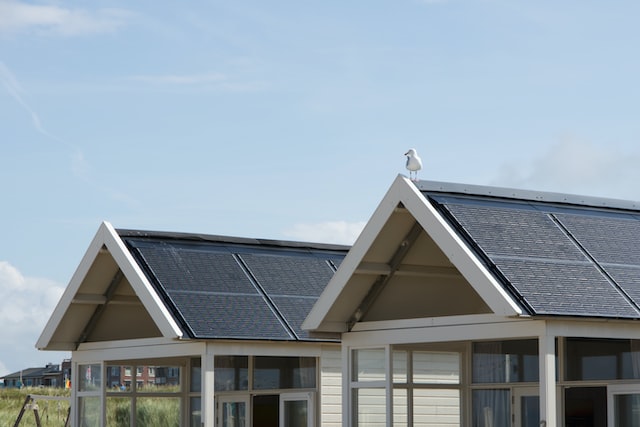Video – https://youtu.be/ccm1HmxELlQ
If you are looking for a way to save on utilities and want to supply your home with green energy, then you are already familiar with the solar panel system. These are easy-to-use converters of solar rays into electrics, which can not only power the system at home but also heat water and the premises themselves. If you have questions about which batteries to choose and how to buy solar panels, we will try to answer them.
The main criteria for choosing solar panels
As with the choice of any system for your home, finding the optimal solution for solar panels must be approached individually, taking into account the basic requirements for your particular needs.
The main characteristics of solar panels are as follows:
- Price;
- Number of panels;
- Efficiency;
- Thermal coefficient;
- Panel type;
- Power.
Each of the criteria has its own parameters that you need to understand in order to understand which solar panel system for your house is right for you.
Cost of solar panel systems for home
It is difficult to say a specific price for a particular system. Moreover, the cost varies every year and depends on the region. But there are parameters on which the price of solar panel system kits depends:
- Size – measured in Watts;
- Brand – the more famous the manufacturer, the more expensive the solar panels;
- Physical size – the larger the kit, the more expensive it is;
- Production material – mono or polycrystalline, or maybe thin-film panels;
- Durability – most often, the warranty period determines it.
It is necessary to say that the most expensive kits do not give you a guarantee that they are suitable for your home or will last a long time. But also do not buy the cheapest options, as they may not be powerful enough or of high quality.
There is a solar panel system calculator you can use to calculate the cost.
Number of panels
The following conditions affect this selection parameter:
- The size of the installation site – even if you need a large coverage area to cover all your needs but you do not have enough space on the roof or at another installation site, you will have to limit the number of panels and compensate for part of the electrics from the general network;
- Energy consumption per day – this refers to the average number for the year. Also, consumption depends on the number of people who live in the house. Additional consumption can be, for example, the operation of equipment in the workshop, air conditioners in summer;
- Solar Hours – In Washington and California, the intensity of sunlight is different, as is its duration, so the number of hours during which the sun actively affects the surface of the panel must be calculated for different regions.
To define the right size kit for your home, you must determine all of these parameters beforehand.
Solar Panel Efficiency
This parameter is always specified for different panel types. Expressed as a percentage, it means the part of the sunlight that the panel is able to convert into electricity. But you should know that the performance indicator is not a constant value. A number of factors influence it:
- The age of the panel – every year, the panel loses about 0.5% of its efficiency, so it is better to think ten times whether it is worth buying an already used solar panel, even if it is cheaper;
- Placement – it is better to entrust the installation site of a set of panels to a specialist who will take into account all factors;
- Frequency of cleaning – maintenance of the panels is extremely important. If the surface is dirty, the efficiency drops quickly;
- Temperature conditions – with significant ambient temperatures, the efficiency of the panels decreases.
Pay attention to the power guarantee offered by the manufacturer. It indicates the effectiveness of the panels after a certain period, which the company guarantees.
Temperature coefficient
We have already mentioned this parameter in efficiency. That is, the air temperature in your region is important to you. The lower the temperature coefficient, the better. It relates a drop in efficiency to a one-degree Celsius rise in temperature.
Panel type
When it comes to standard panels, then all are made of silicon, but they are divided into two types: monocrystalline and polycrystalline.
Monocrystalline panels have greater efficiency, and the indicator ranges from 15% to 20%. This type of panel is more expensive. The visual difference is black.
Polycrystalline panels – less efficient – from 13% to 16% but cheaper. The blue color of the working surface can distinguish them.
Thin-layer panels – there are several types of them. They can be flexible, in different colors, in the form of a film on windows. But this whole group has one drawback – they are less efficient than standard panels. A specialist should choose which type is most suitable for your operating conditions. It is very tempting to seal the windows with a special film and not get involved in the installation of batteries on the roof, but, alas, this is possible only in isolated cases.
Power
The output power indicator shows how much power the battery can generate at the output. The average value is from 250 W to 360 W, but you can choose more powerful batteries with an output power of 400 W.
The consumption of electricity in the house determines the output power. Most often, it can be calculated from electricity bills: you need to indicate how many watts were in use at a certain time.
It is the power that is one of the most crucial criteria for determining the number of panels in one set.
Conclusion
You don’t have to know how a solar panel system works, but you do need to know how to choose the right battery to solar power your home. If you have already calculated your basic parameters, you can use the solar panel kit cost calculator. But this value will not be final since there are some nuances that only a specialist can determine. And they will affect the price, but not necessarily in the direction of its increase. The panels may turn out to be cheaper than the cost computed by the calculator.




